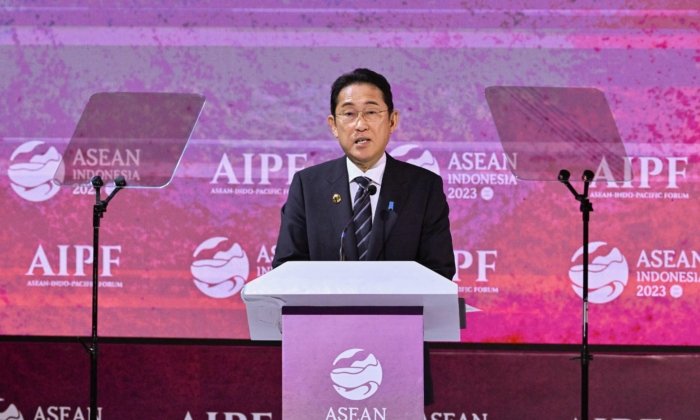Japan Adjusts Defense Policy in Response to Rising Regional Security Threats
Japanese Prime Minister Fumio Kishida recently attended the review ceremony for the Japan Air Self-Defense Force (JASDF). He pledged to increase the defense budget to boost Japan’s defense capabilities. Mr. Kishida referred to the military behaviors of North Korea, China, and Russia as major threats to Japan’s regional security.
On Nov. 11, the JASDF held its annual review ceremony. Mr. Kishida delivered a speech, saying, “The country is in the midst of the harshest and most complex security environment it has faced since the end of World War II.” Mr. Kishida accused Russia of a clear violation of international law in its invasion of Ukraine. The Japanese government views North Korea’s nuclear program as a major threat to regional security. In addition, China and Russia’s increasingly aggressive military behavior is also expanding. In December last year, the Kishida administration approved three new strategic documents, aiming to strengthen Japan’s defense capabilities and maintain Japan’s ability to fight back and defend itself.
Strengthening Japan’s Military Alliances
To ensure Japan’s air superiority, Mr. Kishida mentioned that Japan, Britain, and Italy will jointly develop a new generation of fighter aircraft. The three countries are looking to share technologies in developing new military capabilities. Japan also is looking to revise its “Three Principles on Transfer of Defense Equipment and Technology” in order to allow Japan to export air-defense missiles to the United States since the United States’ long-term support for Ukraine is draining its missile arsenal. The revision of the three principles also will allow Japan to respond appropriately to future events in Taiwan. On Nov. 13, Taro Aso, vice president of Japan’s ruling Liberal Democratic Party (LDP), spoke at a seminar organized by the think-tank Australian Institute of International Affairs, stressing the need for Japan, the United States, and Australia to join forces and reject the Chinese Communist Party’s (CCP) attempt to change Taiwan’s status by force.
He also suggested including Japan in the AUKUS (Australia-United Kingdom-United States) security framework centered on deploying nuclear submarines in Australia. Mr. Aso pointed out that if China were to use force against Taiwan, it would probably first attack islands such as Kinmen and the Mazu Islands, which are located close to mainland China. If Japan, the United States, and Australia react weakly, or insufficiently, China will interpret that as favorable conditions for the Chinese military to attack Taiwan’s main island. He strongly advocated for trilateral cooperation among Japan, Australia, and the United States to face the challenging security environment.
Naval forces from the United States, Japan, Canada, and Australia, who are holding joint military exercises in the Pacific Ocean, held a press conference aboard the USS Carl Vinson on Nov. 11. There, Japanese Vice Admiral Akira Saito said, “As threats to maritime security, such as attempts to unilaterally change the status quo by force, are increasing, strong cooperation with navies of other countries is necessary.”
Japan’s Strategic Change in Defense Policy
The Japan Institute of International Affairs, a foreign policy and security think tank, has recently published in its monthly magazine, International Affairs, a report on Japan’s three new strategic documents that the Kishida administration approved on Dec. 16, 2022, namely the National Security Strategy, the National Defense Strategy, and the Defense Buildup Program. This can be regarded as a historic change in Japan’s postwar security and defense policy since Japan is considering the realistic possibility that its territorial sovereignty may come under attack. This is a significant change from Japan’s historically pacifist approach to national defense after World War II. The report explained that the aim of the three documents is not only to strengthen Japan’s defense and diplomatic capabilities but also to systematically strengthen Japan’s economic strength, technological advantage, intelligence capabilities, and other comprehensive security capabilities. The three documents were introduced in the context of the Russian invasion of Ukraine in February 2022, the U.S. withdrawal from Afghanistan in August 2021, and NATO’s 2022 Strategic Concept.
Initially, NATO defined Russia as the most significant and immediate threat at its 2022 Madrid summit. Japanese Prime Minister Fumio Kishida was invited for the first time to the meeting, and he emphasized that today’s Ukraine could be tomorrow’s East Asia and urged NATO to be aware of China’s growing threat. After the adoption of the three documents by Japan, the Chinese regime increased its military aggression in the Taiwan Strait, East China Sea, and South China Sea, which led to the endorsement of the three documents by Japanese lawmakers across the political spectrum. Japan increased its 2023 defense budget by a whopping 26 percent, which was the largest year-over-year nominal increase since 1952.
Source link




